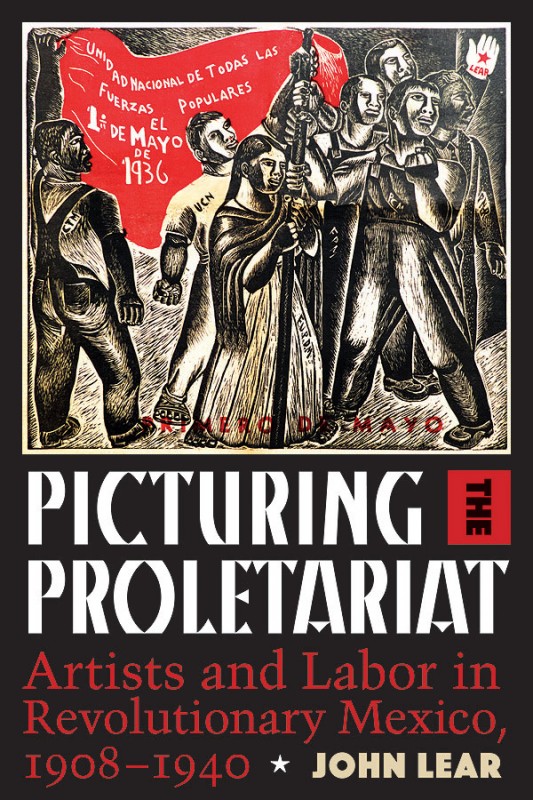Artists and Labor in Revolutionary Mexico, 1908–1940
TACOMA, Wash. – The avant-garde creativity, folkloric beauty, and social torment of Mexican art in the first half of the 20th century tells only a small part of the story of artists’ significance during that turbulent time.
As John Lear argues in his new book, Picturing the Proletariat, the artists who aspired to be the intellectual leaders of the working class played as much a role in 1910–1940 post-revolutionary Mexican society as the peasant farmers with their demands and the generals with their guns.
Picturing the Proletariat: Artists and Labor in Revolutionary Mexico, 1908–1940 (University of Texas Press, January 2017) emerged from an idea pursued by John Lear, University of Puget Sound professor of history and Latin American studies—that “art both reflects and shapes the world in which it is produced.”
The idea, Lear acknowledges, holds little surprise for politically engaged artists or for anyone who has seen the monumental, government-sponsored murals painted on Mexico’s public buildings by “los tres grandes”: Diego Rivera, José Orozco, and David Siqueiros.
Lear’s new book, however, takes the reader much further into understanding the parallel paths of Mexico’s organized labor and its artists’ collectives, and into the relationships among these groups and the state. Using almost 150 art visuals, historical analysis, and personal narratives, Lear shows how, in the wake of Mexico’s 1910–1920 revolution, artists played a fundamental role in constructing a new national identity centered on working people.
Donning the overalls of the working class, the artist created drawings and paintings of Mexicans in this symbolic “unifying” uniform, and thereby helped reduce the divide between rural and urban workers, the skilled and unskilled, the intellectuals and the workers. After a century of mutual indifference, organized labor leaders and middle-class artists began to repeatedly cross paths and share paths.
Showcasing forgotten and neglected prints, photographs, posters, and murals, Lear explores how artists and labor unions participated in the transformation of Mexico from 1908, through the presidency of Lázaro Cárdenas (1934–1940). Lear also shows how middle-class artists, radicalized by the revolution and the Communist Party, sometimes supported and sometimes challenged the unions and the state with avant-garde and nationalist elements in their work.
“This superb study intertwines a history of artistic representations of Mexican workers on public walls and in labor publications with that of the artists who produced them,” wrote John Mraz, research professor at Benemerita Universidad Autónoma de Puebla, in Mexico. “I know of no other work that attempts such an endeavor and, though it is an ambitious project, it is most successful. The scholarship is impeccable.”
“A very finely researched work on Mexican political/worker art, which, in the first half of the 20th century, was globally recognized as a unique and outstanding contribution to modernism and to politics,” wrote Mary Kay Vaughan, professor emerita of history at University of Maryland College Park. “The book is particularly engaging and innovative in its focus on ‘lesser’ artists, whose work turns out to be politically, socially, and historiographically important.”
Picturing the Proletariat explores visual narratives that offer competing interpretations of the issues of gender, class, nationalism, and internationalism that came to define the modern Mexican identity. It gives the reader a fresh and thought-provoking perspective on the art and politics of the Mexican revolution.
John Lear is professor of history and Latin American Studies at University of Puget Sound in Tacoma, Wash. Lear’s research interests include Mexico, Chile, Cuba, post-independence Latin America, comparative labor and urban history, cultural politics, gender, and social movements. His first co-authored book, Chile’s Free-Market Miracle: A Second Look (1995), examined neo-liberal policies in Chile. He also wrote Workers, Neighbors and Citizens: The Revolution in Mexico City (2001), which explored urban mobilization in the Mexican Revolution.
Picturing the Proletariat can be purchased in hardcover or paperback here: https://utpress.utexas.edu/books/lear-picturing-the-proletariat
Press photos of John Lear and the book cover can be downloaded from pugetsound.edu/pressphotos.
Photos on page: From top right: The book cover; Revista CROM union magazine cover (1925); Revista LUX magazine cover, by Santos Balmori, 1936; John Lear, by Ross Mulhausen.
Tweet this: Mexican #Art #labor & post-revolutionary change. New book #PicturingtheProletariat, by John Lear @univpugetsound http://bit.ly/2js54A1
Follow us on Twitter! twitter.com/univpugetsound



